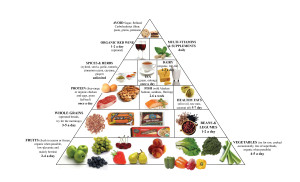Thank you to all of you who joined me at Sierra Sundance last night. There was a good turnout and I really appreciated all questions and feedback. If there’s any part of the discussion that I did not make clear please don’t hesitate to contact me.
I’ve received a few responses and one request for more clarification on what grains to eat and what fats to eat. Even though I stressed the importance of eating primarily organic vegetables as your main source of carbohydrates and preferably 7 to 9 servings a day, it’s beneficial to have a grain with a meal. I’ve put together a list but caution you if you are sensitive to a particular grain. If you suspect or know that you have a sensitivity or a true allergy to a grain, PLEASE don’t consume it.
Top 10 Super Grains:
- Amaranth: Is high in protein and calcium. One cup of amaranth has about 28 grams of protein and 300 milligrams of calcium.
- Barley: High in fiber. One cup of barley has 6 grams of fiber and only 193 calories.
- Millet: Is an African grain widely consumed in China. Good source of niacin, folic acid, iron, potassium, magnesium and zinc. Plus it’s gluten free.
- Quinoa: Considered a grain but actually a relative of leafy green vegetables. High in manganese, fiber and protein. One forth cup has 6 grams of protein and 4 grams of fiber
- Rye: Are higher in protein, iron and potassium than wheat. They have nice chewy texture and great with oats as a winter cereal.
- Oats: High in fiber and studies has shown that eating rolled oats on a regular basis can lower cholesterol.
- Spelt: Nice nutty sweet flavor, high in protein and easy to digest. Can be used instead of wheat to make high protein breads.
- Kamut: Has a rich buttery flavor and chewy texture. Higher in protein than wheat by about 30%.
- Kasha: Full of B vitamins and rich in phosphorous, potassium, iron and calcium. Kasha is roasted hulled buckwheat kernels and is a staple of the Russian diet.
- Teff: A nutritional powerhouse from North Africa. High in protein, iron and calcium. Great as a hot breakfast cereal.
Last night I touched on briefly the Standard American Diet (acronym S.A.D.) emphasizing how many carbohydrates are included in the pyramid. I do have a more relevant pyramid to my practices on file and did include it in this blog. I must mention that this new diagram isn’t perfect. It mentions 1-2 glasses of organic red wine per day and only one form of protein per day. Contrary to this pyramid, more than 4 drinks per week can actually add chronic stress to the body so please keep this in mind. In addition I’m firm that protein should be a part of every meal for it provides sustenance (‘feeling full’ for longer periods of time)and improves the recovery period for muscle repair (illness, tears, overuse).
Lastly, remember to add good fats to every meal: they’re an excellent source of fuel for the body and brain and per gram provide less calories than carbohydrates (for those calorie counters out there!). Healthy fats include: olive oil, raw nuts, seeds, coconut oil, avocados, coconut cream/milk, olives, etc.
Any questions or comments? I’d love to hear from you.
Be well,
Lynn

 January 10th, 2014
January 10th, 2014  Lynn
Lynn 
 Posted in
Posted in 